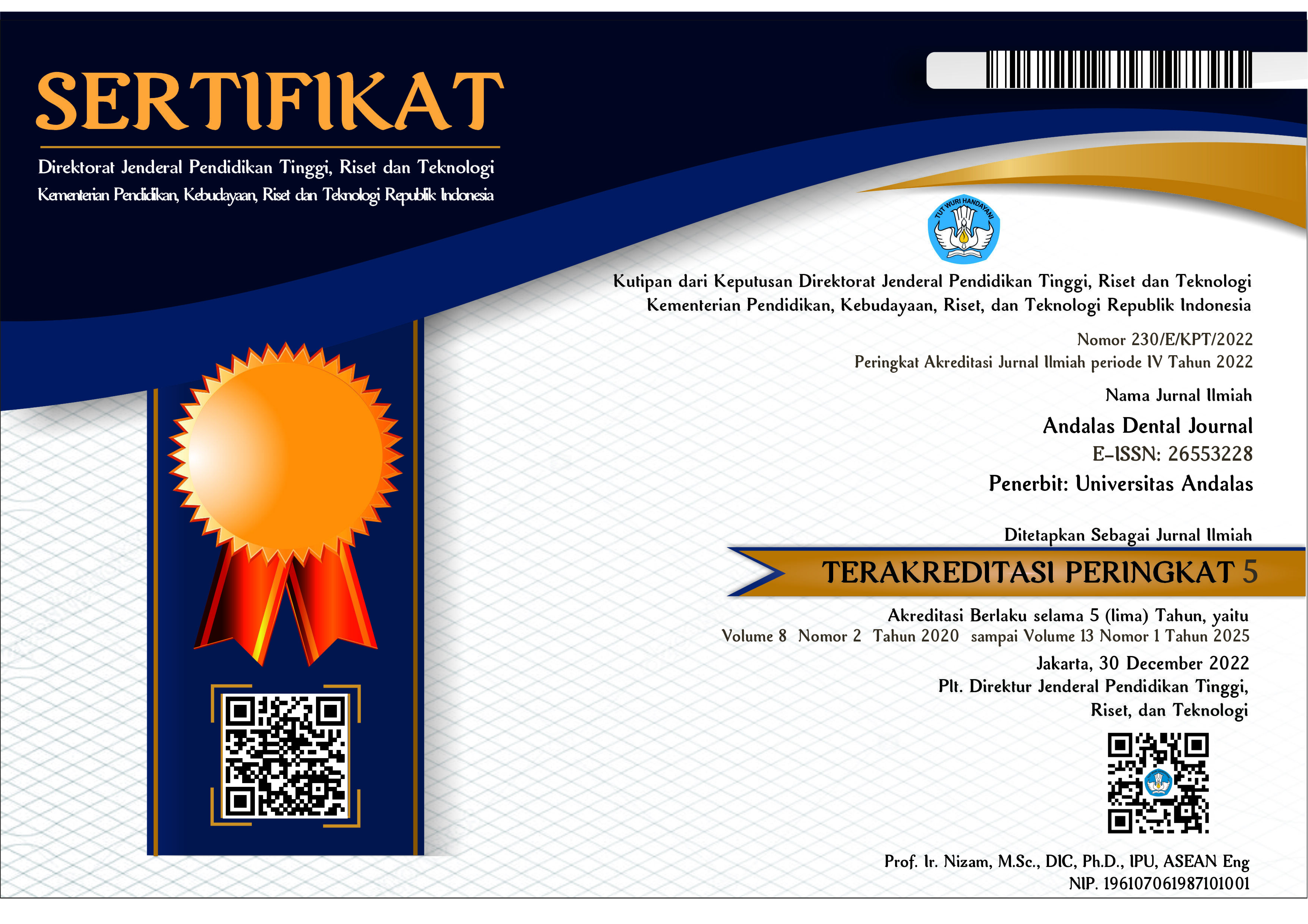Hubungan Oral Hygiene Habits dengan Early Childhood Caries (ECC) pada Balita Di Kota Padang
Abstract
Dental caries is a disease of hard tissue of the tooth due to bacterial activities that cause loss mineral structure of the tooth. Dental caries that occur in deciduous teeth on children under 71 months is called Early Childhood Caries (ECC). Dental caries is still one of the most common dental and oral health problem experienced by children in the world. Some surveys in Cambodia and Indonesia show that a high prevalence and severity of ECC which was 90% in children aged 3-5 years. Oral hygiene habits were identified as one of the risk factors of caries. Some studies suggest that there is a strong relationship between the behavior of maintaining oral hygiene and the prevalence of dental caries. The purpose of this study is to determine the relationship between oral hygiene habits and early childhood caries on toddler in Padang. This study used cross sectional design. The samples of this study was 107 childrens aged 3-5 years in Padang. The location was selected through stratified random sampling technique and samples was selected through consecutive sampling techniques. Data was collected in Gunung Pangilun village and Piai Tanah Sirah village. Data was collected using a questionaires and intraoral examination. Data was analyzed by Chi-Square with p<0,05. The result of this study that there was a significant relationship between oral hygiene habits and ECC on toddler in Padang (p=0,008). The conclusion of this study was that oral hygiene habits is associated with early childhood caries on toddler in Padang.
References
2. Quock RL. Dental Caries: A Current Understanding and Implications . Journal of Nature and Science; 2015. p. 1-4.
3. Cameron AC, Widmer RP. Handbook of Pediatric Dentistry 4th editon. Sydney: Mosby; 2013.
4. Subramaniam, P., and Prakash, P. (2012). Prevalence of early childhood caries in 8 - 48 month old preschool children. Contemporary Clinical Dentistry, 15-21.
5. Meyer F, Enax J. Early Childhood Caries: Epidemiology, Aetiology, and Prevention. International Journal of Dentistry; 2018. p. 1-7.
6. Anil S, Anand PS. Early Childhood Caries : Prevalence,Risk Factor, and Prevention. Frontiers in Pediatrics; 2017; 5: 157.
7. WHO. WHO Expert Consultation on Public Health Intervention against Early Childhood Caries Report of A Meeting In Bangkok, Thailand. 26-28 January 2016.
8. Colak H, Dulgergil CT, Dalli M, Hamidi MM. Early childhood caries update: A review of causes, diagnoses, and treatments. Journal of Natural Science, Biology and Medicine; 2013. p. 29-38.
9. Prakash, P., Subramaniam, P., Durgesh, B. H., and Konde, S. Prevalence of Early Childhood Caries and Associated Risk Fctor in Preschool Children of Urban Bangalore, India: A Cross-Sectional Study. European Journal of Dentistry. 2012; 6: 141-152.
10. Astari P, Roesnor M, Utami SP. Prevalensi Karies Rampan pada Anak Usia Balita di Taman Kanak-Kanak Kota Pdang. Journal B-Dent. 2014; 1: 97-101.
11. Susi S, Murniwati M, Kasuma N, Minarni M. Analysis of Breastfeeding Pattern with Early Childhood Caries. World Journal of Dentistry; 2018. p. 197-200.
12. Santos AP, Nadanovsky P, Oliveira BH. A systematic review and metaanalysis of the effects of fluoride toothpastes on the prevention of dental caries in the primary dentition of preschool children. Community Dentistry and Oral Epidemiology; 2012. p. 1-12.
13. Hong CH, Bagramian RA, Nainar SH, Straffon LH, Shen L, Hsu CYS. High caries prevalence and risk factors among young preschool children in an urban community with water fluoridation. International Journal of Paediatric Dentistry; 2014. p.32-42.
14. Olatosi O, Sote E. Causes and pattern of tooth loss in children and adolescents in a Nigerian tertiary hospital. Nig Q J Hosp Med; 2012. p. 58-62.
15. Chu CH, Ho PL, Lo EC. Oral health status and behaviours of preschool children in Hongkong. BMC Public Health; 2012. p. 12:767.
16. Ghazal T, Levy SM, Childers NK, Broffitt B, Cutter GR, Wiener HW, et al. Factors associated with early childhood caries incidence among high caries-risk children. Community Dentistry and Oral Epidemiology; 2015. p. 366-374.
17. Jain, M., Namdev, R., Bodh, M., Dutta, S., Singhal, P., and Kumar, A. (2015). Social and Behavioral Determinants for Early Childhood Caries among Preschool Children in India. JODDD, Vol. 9, No. 2, 115-120.
18. Olatosi O, Inem V, Sofola O, Prakash P, Sote E. (2015). The prevalence of early childhood caries and its associated risk factors among preschool children. Nigerian Journal of Clinical Practice Vol 18, 493-501.
19. Wright JT, Hanson N, Ristic H, Whall CW, Estrich CG, Zentz RR. Fluoride toothpaste efficacy and safety in children younger than 6 years . The Journal of American Dental Association; 2014. p. 182-189.
20. Perera PJ, Abeyweera NT, Fernando MP, Warnakulasuriya TD, Ranathunga N. Prevalence of dental caries among a cohort of preschool children living in Gampaha district, Sri Lanka: A descriptive cross sectional study . BMC Oral Health; 2012. p. 1-6.
21. American Dental Association. Healthy Habits. http://www.mouthhealthy.org/en/babies-and-kids/health-habits. (cited 17 Februari 2019).
22. Dini EL, Holt RD, Bedi R. Caries and its association with infant feeding and oral health - related behaviours in 3-4 -year-old Brazilian children. Community Dentistry and Oral Epidemiology; 2000. p. 241-248.
23. Dabawala S, Suprabha BS, Shenoy R, Rao A. Parenting style and oral health practices in early childhood. International Journal of Paediatric Dentistry; 2016.
24. Seow K. Environmental, maternal, and child factors contribute to ealy childhood caries : a unifying conceptual mode. International Journal of Pediatric Dentistry; 2012. p. 157-168.
25. Sukanto. Takaran dan Kriteria Pasta Gigi yang Tepat Untuk Digunakan Pada Anak Usia Dini. Stomatognatic (J.K.G) Unej. 2012; 9(2).
26. Sumerti N. Faktor-faktor yang Berhubungan dengan Perilaku Ibu dalam Deteksi Dini Karies Gigi pada Anak Balita di Kecamatan Kuta Utara Kabupaten Badung. Jurnal Kesehatan Gigi; 2013.
27. Al-Meedani LA, Al-Dlaigan YH. Prevalence of dental caries and associated social risk factors among preschool children in Riyadh, Saudi Arabia. Pak J Med Sci. 2016; 32(2): 452-456.
28. Evans GT, Junger M, Lin M, Wei L, Espinoza L, Aguilar EB. Use of Toothpaste and Toothbrushing Patterns Among Children and Adolescents — United States, 2013–2016. Morbidity and Mortality Weekly Report. 2019; 68.
29. Cameron, A. C., and Widmer, R. P. (2008). Handbook of Pediatric Dentistry. Sydney: Elsevier.
30. Zeng L, Zeng Y, Zhou Y, Wen J, Wan L, Ou X, et al. Diet and lifestyle habits associated with caries in deciduous teeth among 3- to 5-year-old preschool children in Jiangxi Province, China. BMC Oral Health; 2018.
31. AAPD. Guideline on Infant Oral Health Care. Clinical Practice Guidelines; 2014. p. 146-150.
32. AAPD. Policy on Early Childhood Caries (ECC): Classifications,Consequences, and Preventive Strategies. Refference Manual. 2016; 40: 60-62.
33. Maulidta KW, Wahyuningsih, Hastuti S. Hubungan Kebiasaan Menggosok Gigi dan Konsumsi Makanan Jajanan Kariogenik dengan Kejadian Karies Gigi pada Anak Usia Prasekolah di Taman Kanak-Kanak Pohon Beringin Semarang. JITK; 2010.
34. Percival T, Edwards J, Barclay SSaB, Majumder MA. Early Childhood Caries in 3 to 5 Year Old Children in Trinidad and Tobago . Dentistry Journal; 2019
35. Plonka K, Pukallus M, Barnett A. A longitudinal case-control study of caries development from birth to 36 months. Caries Research; 2013.
36. Seow K. W. Early Childhood Caries. Elsevier; 2018.
37. Garg N, Garg A. Textbook of Operative Dentistry. New Delhi: Jaypee Brothers Medical Publishers (P) Ltd; 2013.
Copyright (c) 2020 Zhafirah Muharani Nasution, Reni Nofika, Susi Susi

This work is licensed under a Creative Commons Attribution-ShareAlike 4.0 International License.















